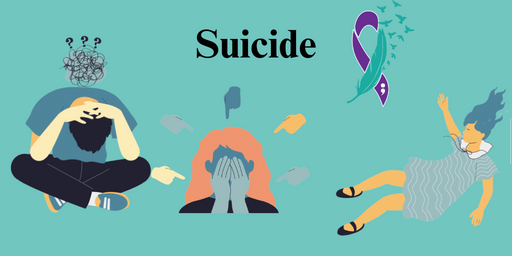Attitude Toward Suicide and Health Care Provider


What is Suicide
Suicide is defined as a death that is the result of an intentional self-destructive act. Nurses have demonstrated a great deal of clinical and theoretical interest in suicide, suicide attempts, attitudes toward suicide, and assisted suicide but have conducted very little research on these topics.
A
related topic that has been studied fairly extensively by nurses is suicide
survivors, those family members and significant others who are bereaved by a
suicide.
Suicide in Health Care
Few nursing studies have addressed suicide specifically. Using a qualitative methodology, messages of psychiatric patients who at tempted or committed suicide were compared by Valente (1994). She found that clear suicidal messages were sent by most of these psychiatric patients and that the messages of suicide completers and suicide attempters could be differentiated.
Demi, Bakeman , Sowell, Moneyham , and Seals (1996) studied. suicidality in HIV-infected women and found that suicidal thoughts were common among the women and that family cohesion moderated the effect of HIV-related symptoms on emotional distress.
They also found that there were clear differences between women who neither thought about nor attempted suicide and those who thought about or attempted suicide, but there were no significant differences between those who thought about suicide and those who attempted it.
Grabbe , Demi,
Camann , and Potter (1997) used a national database to assess suicidal risk
factors among the elderly during their last year of life; Using logistic
regression, they confirmed the traditional risk factors of age, race, gender,
alcohol use, and mental illness and provided preliminary evidence that cancer
is also a risk factor among the elderly.
Addiction and Suicidal Thoughts
Several studies addressed adolescent suicide. Burge, Felts, Chenier, and Parrillo (1995), using a national database, studied suicidal behaviors among US high school students and found a significant positive relationship between cocaine use and severity of outcomes of suicide attempts.
They also found a significant but less strong relationship between marijuana use, alcohol use, sexual activity, and suicide attempts. Rew , Taylor- Sechafer , and Fitzgerald (2001) found that among homeless youths 35.1% had seriously considered suicide during the past 12 months and 12.3% had actually attempted suicide; they also found that participants with a history of sexual abuse were more likely to have considered suicide in the past 12 months.
In another study
Rew , Thomas, Horner, Resnick, and Beuhring (2001) found that among a group of
Tri ethnic adolescents Hispanic Latina girls had significantly higher suicide
attempts than any other ethnic gender group.
Nurses Attitude Toward the Suicide in Diverse Group of Patient
Several studies by nurses have investigated nurses' attitudes toward suicide in diverse groups. Oncology nurses' knowledge and misconceptions about suicide were explored through the use of a vignette depicting a suicidal cancer patient.
Although the nurses correctly identified a number of risk factors, few knew that race, age, and gender were risk factors. Furthermore, few nurses assessed whether patients had a specific suicide plan, and less than one third identified appropriate interventions to prevent suicide in an at-risk patient.
Another study compared nurses' attitudes toward suicide based on their clinical specialty, age, and highest degrees; they found no significant differences on any of the subscales based on clinical specialty, although age and degrees were significant on only the right-to-die subscale.
A comparison of
doctors' and nurses' attitudes towards the suicide of young people revealed few
differences (Anderson, M., Standen, Nazir, & Noon, 2000). Another study
explored patients' and psychiatric nurses' opinions regarding care for
in patients; Nurses and patients believed that communicating with patients is
the most important skill in psychiatric nursing (McLaughlin, 1999).
Suicidal Attempts in Economical Caresses
The only study of non-nurses explored attitudes toward suicide
among low-income, elderly, inner city residents and compared attitudes toward
suicide of men and women, African Americans and Whites, finding not significant
differences. The researchers suggested that social class and place of residence
may be better predictors of attitudes toward suicide in the elderly than race
and gender (Parker, Cantrell, & Demi, 1997).
Several studies explored the effectiveness of “no-suicide
contracts” with conflicting: findings. Some found that there is no support for
the effectiveness of no-suicide contracts; however, others note that no suicide
contracts are negotiated when there is a high risk of suicide. There is general
consensus that there should be national standards for observation of patients
identified as at risk for suicide.
Causes of Suicide
Many studies have been conducted on suicide survivors, including parents, spouses, children, siblings, and therapists. Most of the studies of suicide survivors have been descriptive and have found that a death by suicide produces extreme distress in the survivors, with evidence of increased guilt, stigma, and resentment and a continuing questioning of “why” the suicide occurred.
Several studies have compared those bereaved by suicide with those
bereaved by other modes of death and have reported conflicting findings.
Suicidal Risk Population and Euthanasia
The suicide rates for the elderly are rising. At the same time, there is increased interest in euthanasia and assisted suicide. Nurses are intimately involved with elderly and terminally ill patients who are contemplating suicide and assisted suicide.
Matzo and Emanuel (1997) found that nurses were more likely to have performed patient assisted euthanasia than physicians; however, the number who admitted to hastening a patient's death was very small. Much more research attention should be directed to this topic.
Researchers should move beyond describing attitudes toward suicide and effects of suicide on survivors and toward studying interventions to prevent suicide, to help nurses cope with requests for assisted euthanasia, and to assist those coping with a death by suicide.




Give your opinion if have any.